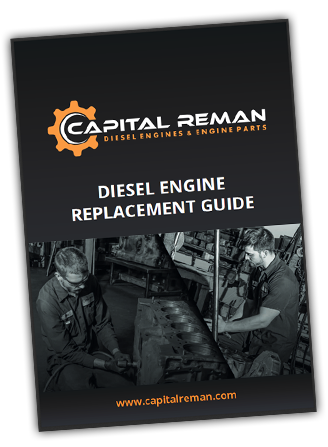7 Reasons For Low Oil Pressure in a Diesel Engine
 When low oil pressure is detected the immediate response is to think the worst. However, most issues can be resolved with simple solutions. This article explains 7 of the most common causes for low oil pressure in a Caterpillar C7 but the principals can apply to the majority of diesel engines.
When low oil pressure is detected the immediate response is to think the worst. However, most issues can be resolved with simple solutions. This article explains 7 of the most common causes for low oil pressure in a Caterpillar C7 but the principals can apply to the majority of diesel engines.
Before any inspection begins it is important to take a few precautions before tearing into the engine. Remember to keep all parts clean and free of contaminants. Any dirt or debris that gets into the engine can cause wear, misalignment of critical parts or clog various oil passageways. Use of an oil pressure gauge will determine if the problem is in the top end or bottom end of the engine.
It is also important to note to contain all fluids when inspecting the parts of the engine. Try your best to maintain critical fluid levels as best you can to ensure parts of the engine are not contaminated. Also dispose of all fluids according to local and federal regulations.
1. Engine Oil Level Is Low:
The first place to check if the oil level is low is the crankcase. The most common problem is that there is simply not enough oil in the engine. The oil level may simply be below the oil pump supply tube. Simply put, this will cause the oil pump not to work as it does not have the ability to pump oil to the engine components. The solution is to simply add the correct level of oil to the engine. Make sure to refer to “Refer to Operation and Maintenance Manual” for the recommended oil for your engine.
2. Engine Oil Is Contaminated:
 Fuel or coolant in the oil will cause low engine oil pressure. Excess fluids in the oil consequently will cause high oil levels in the crankcase. High oil levels in the crankcase will generally always point to excessive fluid leaking somewhere else in the engine. Common contaminants include diesel fuel, coolant, or water. The engine builder will then have to determine the source of the fluid leak and make appropriate repairs. After the source of the contamination is found and fixed the oil should be drained and refilled with the approved grade of oil. It is also recommended to change the oil filter. Sometimes the low oil pressure is due to something so small as a clogged oil filter.
Fuel or coolant in the oil will cause low engine oil pressure. Excess fluids in the oil consequently will cause high oil levels in the crankcase. High oil levels in the crankcase will generally always point to excessive fluid leaking somewhere else in the engine. Common contaminants include diesel fuel, coolant, or water. The engine builder will then have to determine the source of the fluid leak and make appropriate repairs. After the source of the contamination is found and fixed the oil should be drained and refilled with the approved grade of oil. It is also recommended to change the oil filter. Sometimes the low oil pressure is due to something so small as a clogged oil filter.
Caterpillar oil filters are built specifically for Caterpillar engines. That being said there are aftermarket oil filters that will do the job just fine. OEM dealers will recommend the use of propriety oil filters stating unauthorized filters will allow larger particles into the engine potentially causing damage to the bearings, crankcase etc… but most of that is simply untrue. Aftermarket filters are built to the exact same standards at the OEM ones.
3. Engine Oil Bypass Valves Are Open:
 Oil Bypass Valve
Oil Bypass Valve
If the engine oil bypass valvesare set in the “Open” position, it can result in lower engine oil pressure. The cause of open bypass valves is usually debris in the engine oil. Debris could be dirt or metal shavings from internal damage from one of the internal hard parts (camshaft, crankshaft, pistons etc…) The solution to this issue is to remove each oil bypass valve and clean out any dirt or debris. It is also wise to clean each bypass valve bore. Once the bypass valves are cleaned the oil should be changed as well as the oil filter.
4. Oil Lines or Oil Passages Are Not Working:
An oil line or oil passage that is open, broken or disconnected will cause low engine oil pressure. The engine builder should check each oil passage for debris and wear. Sometimes oil galleries can be out of alignment where the holes are not lined up correctly to allow normal oil flow. Check that the oil lines are hooked up properly and that there is not a tear in the line. An open lubrication system could also be caused by a piston cooling nozzle that is missing or damaged. Piston cooling nozzles direct engine oil towards the bottom of the piston in order to cool the piston. These nozzles also provide lubrication for the piston pin. Incorrect installation, restriction of normal movement or breakage of the piston cooling nozzlescould result in the seizure of the piston itself.
An open lubrication system could also be caused by a piston cooling nozzle that is missing or damaged. Piston cooling nozzles direct engine oil towards the bottom of the piston in order to cool the piston. These nozzles also provide lubrication for the piston pin. Incorrect installation, restriction of normal movement or breakage of the piston cooling nozzlescould result in the seizure of the piston itself.
5. Restriction in the Oil Suction Tube - Low Oil Pressure:
There is an inlet screen in the oil suction tube which can get clogged or damaged. This restriction will cause cavitation and a loss of engine oil pressure. The solution is to check the inlet screen on the oil pickup tube and remove any material that may be restricting oil flow. Low engine oil pressure may also come from the oil pickup tube not sitting properly and drawing in air vs. oil. Check the joints of the oil pickup tube for cracks, alignment or a damaged O-Ring seal. The best way gain access to the oil pickup tube is by removing the oil pan.
6. Problems with the Oil Pump:
Any sort of air leakage in the supply side of the oil pump will also cause cavitation (back pressure) and loss of oil pressure. The engine builder should check the supply side of the oil pump and make any necessary repairs.
The other common issue with the oil pump is excess wear to the gears. Gears that are out of tolerance will not have enough power to cr eate suction. The engine builder must repair or replace the gears in the oil pump or purchase a new pump.
eate suction. The engine builder must repair or replace the gears in the oil pump or purchase a new pump.
7. Improper Bearing Clearance:
If the engine bearings have excessive clearance it could result in low oil pressure. Check the internal engine components where bearings are present to make sure they are in spec. If the bearings are worn it is advised to replace the bearings or make necessary repairs to the components.

Loss of engine oil pressure is a serious yet common matter with diesel engines. It should be noted that ignoring a low oil pressure warning could result in serious damage to your engine. The best way to keep your engine running is to regularly change the oil and keep the internal parts properly lubricated. Lubrication is life blood of any engine.




